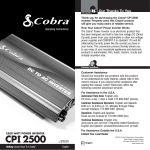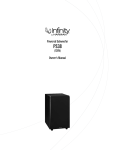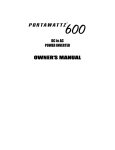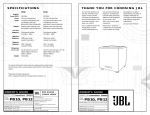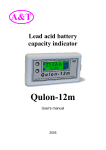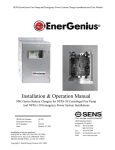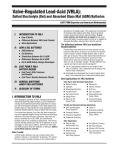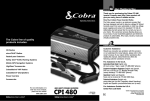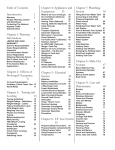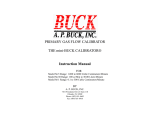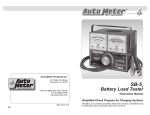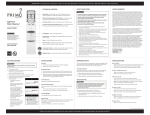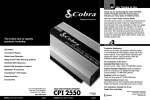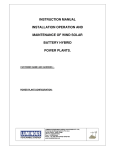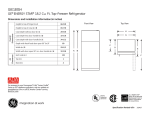Download Guide to Commercial VRLA Batteries (2007)
Transcript
COMMERCIAL / TRUCK Valve-Regulated Lead-Acid (VRLA): Gelled Electrolyte (Gel) and Absorbed Glass Mat (AGM) Batteries TECHNICAL GUIDE A. How it works I: INTRODUCTION TO VRLA II: DISTINGUISHING BETWEEN AGM & GEL III: VRLA PRODUCTS AND SERVICE IN COMMERCIAL VEHICLES IV: TESTING CONSIDERATIONS V: CHARGING CONSIDERATIONS VI: COMMERCIAL BATTERY SYSTEMS VII: ENVIRONMENTAL TEMPERATURES & VENTING CONDITIONS VIII: SAFETY PRECAUTIONS A VRLA battery utilizes a one-way, pressure-relief valve system to achieve a “recombinant” technology. This means that the oxygen normally produced on the positive plate is absorbed by the negative plate. This suppresses the production of hydrogen at the negative plate. Water (H2O) is produced instead, retaining the moisture within the battery. It never needs watering, and should never be opened as this would expose the battery to excess oxygen from the air. In addition to damaging the battery, opening it also voids the warranty. B. The difference between VRLA and traditional flooded batteries Flooded electrolyte batteries do not have special one-way, pressure-relief valves, as they do not work on the recombination principle. Instead, flooded designs utilize a vent to allow gas to escape. They contain liquid electrolyte that can spill and cause corrosion if tipped or punctured. They should not be used near sensitive electronic equipment. They can only be installed “upright.” Flooded batteries lose capacity and become permanently damaged if: • Left in a discharged condition for any length of time (due to sulfation). This is especially true of designs that require water maintenance. • Continually over-discharged (due to active material shedding). This is especially true of commercial starting types. I. INTRODUCTION TO VRLA Valve-Regulated Lead-Acid or VRLA, including Gel and AGM (Absorbed Glass Mat) battery designs, can be substituted in virtually any flooded lead-acid battery application (in conjunction with well-regulated charging). Their unique features and benefits deliver an ideal solution for many applications where traditional flooded batteries would not deliver the best results. For almost three decades, East Penn has been manufacturing valve-regulated batteries using tried and true technology backed by more than 65 years experience. East Penn produces a complete line of Gel, AGM, and conventional flooded products for hundreds of applications. This diverse product offering enables East Penn to be objective as to the advantages of each type of battery. East Penn’s VRLA (Gel and AGM) products have the reputation of being the highest quality VRLA batteries available. II. DISTINGUISHING BETWEEN AGM AND GEL A. AGM (Absorbed Glass Mat) batteries The electrolyte in AGM batteries is completely absorbed in separators consisting of matted glass fibers. This causes them to be spillproof, meaning they don’t leak acid like a flooded design if tipped on their side. The glass mats in AGM batteries are wrapped around the positive plate, which helps prevent damage from vibration and extend cycling. The battery’s groups are packed tightly in the case partitions also protecting its power producing components. AGM battery designs can have over twice the cycle life of a conventional flooded product. B. Gel or Gelled Electrolyte batteries F. Can I mix VRLA and Flooded batteries within the same battery pack? The electrolyte in a Gel battery is permanently locked in a highly viscous gelled state instead of the traditional liquid form. Because there is no liquid-type electrolyte, it will not leak out of the battery if tipped on its side. The thick, gelled electrolyte and tightly packed groups also protect the battery’s power producing components. Gel battery designs have a superior deep discharge resiliency and can deliver up to three times the cycle life of an AGM product No, you cannot mix AGM, Gel, and flooded batteries within the same battery pack. Batteries should be paired together with other batteries of similar age and ratings within the same battery pack. III. Properties of VRLA Products and Service in Commercial Vehicles C. Why use an AGM Battery for Commercial truck. AGM batteries offer superior starting power, high reserve capacity, and long lasting life. The advanced AGM technology and all-purpose design makes East Penn’s AGM battery excellent for quick starts, extended cycling, and deep cycle use like powering accessories and cabin features when the engine isn’t running. East Penn’s heavy cycling AGM batteries are especially designed for the heavy demand of battery powered HVAC systems. All group 31 AGM batteries have the same case/cover configuration as a traditional group 31, which allows it to securely fit and be compatible with existing holddowns. A spillproof construction and minimized gassing makes them safe to use in the driver’s compartment or near sensitive electronic equipment. In addition, this reinforced AGM construction further extends battery life by withstanding the added vibration typical of commercially used vehicles. Today’s commercial applications are being integrated with more electronic and accessory power demands than ever before. New advances in the vehicle’s electrification and battery-powered controls are requiring a greater demand on the batteries’ functions in the vehicle. Independently powered HVAC and APU systems require a deeper cycle service that also differs from the predominate starting service of traditional battery designs. In most cases, it is not enough to just meet the commercial vehicle’s starting requirements. Understanding the cycling or deep cycle demands placed on the battery as well as the individual user’s needs is extremely critical. VRLA batteries can provide solutions to these additional requirements on the battery, and it’s extremely important to understand how they can benefit the many functions batteries serves in today’s commercial vehicle electrical systems. D. Why use a Gel Battery for Commercial truck. A. Starting Service New heating and cooling systems for commercial trucks need a battery with tremendous deep cycle capabilities. HVAC and APU systems require plenty of power dedicated solely for their use. Gelled electrolyte designs are the deepest cycling batteries withstanding multiple charging and recharging in order to provide the continual service demanded by these systems. These maintenance-free batteries are designed to deliver dependable performance cycle after cycle while providing longer battery life. Their spillproof design and minimized gassing makes them safe to use in the driver’s compartment or near sensitive electronic equipment. In addition, the gelled electrolyte withstands the added vibration of commercially used vehicles extending battery life. The predominate function that batteries serve in commercial vehicles is to start the vehicle. However, there are other demands that today’s battery must withstand in order to continue to provide that service. VRLA batteries offer a durability-enhanced design that reinforces the battery so it can continue to deliver dependable starting power, even under demanding auxiliary loads. While the battery’s durability is becoming more and more important, it does not negate the fact that the batteries must meet or exceed the vehicle’s Cold Cranking requirements. Cold Cranking Amps (CCA) is a measure of engine starting ability based on being able to sustain a minimum voltage (7.20) under load for a minimum time period (30 seconds) at a temperature of 0°F. The test is done on a new fully charged battery. Regardless of the actual low temperature, typical cranking duration, minimum acceptable voltage, and lowest expected state of charge; engine manufacturers set their battery requirements relative to this standard reference value. CCA is also measured by some battery testers. Here it is a calculated value proportional to battery conductance and not the results of a standard test. AGM batteries excel for high current, high starting power demanding applications, especially in extremely cold environments. Gel battery power declines faster than an AGM battery, especially as the temperature drops below 32ºF (0ºC). They can be used for starting if the battery meets the CCA requirements of the vehicle, but are usually recommended for deep cycle use. E. Major difference between Gel and AGM battery performance A Gel battery is better suited for super-deep discharge applications, which means it can withstand deeper discharges without damaging the battery’s performance. However, due to the physical properties of the gelled electrolyte, Gel battery power declines faster than an AGM battery as the temperature drops below 32ºF (0ºC). AGM batteries excel for high current, high power applications and in extremely cold environments. AGM batteries deliver a better dual purpose solution for a combination of starting and accessory power. 2 B. Cycle Life SAE J2185 Testing Cycling and Starting Performance (Graph represents general criteria of this test and is not showing results of a particular battery.) Cycle life is how many times you can discharge a battery and recharge the battery again before it degrades to the point it is no longer usable. A battery with extended cycle life survives longer than average under the more grueling demands of less than ideal environments and tough commercial use. This includes warmer climates, higher temperature environments, longer than typical hours of usage, higher annual miles of operation, and frequent electrical loading while the engine is off. The appropriate test for cycle life depends on how the battery is going to be used. As a general rule, high temperature accelerates aging and deeper discharging accelerates capacity degradation giving fewer cycles. Different tests have different definitions of end of life. Some users may be able to tolerate more degradation. If the battery is undersized for its duty, a user may experience problems before the defined end of life. It’s important to remember that if you use energy, you must replace it all, plus an allowance for inefficiency. If you add extra loads to a vehicle, the charging system may be too small to recharge in the time available. SAE J2185 Life on Various Batteries 700-760 CCA Ratings 1. Cycle life testing Good cycle life performance depends on the criteria of the test. For example, if one test shows a battery can perform 1000 cycles, that could be good or bad depending on the test’s criteria. 500 cycles might be an excellent performance on one test but on another test 500 cycles might indicate poor performance. The SAE J2185 is a popular test to determine the effects that cycling will have on the battery’s starting performance. A 25-amp, 1-hour discharge is used to mimic the key-off loads at 122°F. The recharge is accelerated to 2.5 hours. After 26 cycles, there is a rest and a 50-second cranking simulation. The battery could fail during the 25-amp discharge, but in practice, the cranking simulation is the typical point of failure. A single 25 amphere-hour cycle could represent one day of service in a vehicle with excessive hotel loads, or it could represent over a week of loads in a day cab vehicle. The fact that this is an individual battery test should be considered when evaluating the three or four battery system typical in many commercial trucks. In these systems, a single battery is supplying one-third or one-fourth of the vehicle’s needs. 2. Depth of Discharge and Cycle Life Depth of discharge will affect cycle life. The harder any battery has to work, the sooner it will fail. The shallower the average discharge, the longer the life. It’s important to size a battery system to deliver at least twice the energy required, to assure shallow discharges. Follow these tips for the longest life: • Avoid ultra-deep discharges. The definition of ultradeep discharge may vary with application and battery type. • Don’t leave a battery at a low stage of charge for an extended length of time. Charge a discharged battery as soon as possible. • Don’t cycle a battery at a low state of charge without regularly recharging fully. • Use the highest initial charging current available (up to 30% of the 20-hour capacity per hour) while staying within the proper temperature-compensated voltage range. C. Battery Capacity and Discharge Rates Battery capacity is related to runtime at a fixed rate and temperature. It has units that are the product of current multiplied by time (such as ampere-hours). The amperehour is a unit of “charge”. 3 The typical vibration test for on-road trucking applications was a test adopted from the SAE off-road work machine battery standard. This SAE J930 Level 2 test is an 18-hour test at 5.0 peak G-force on the vertical axis at 30-36Hz. TMC RP-125 describes the same test. This test consists of about 2.2 million upward motion reversals and 2.2 million downward motion reversals where each reversal of direction requires the battery to absorb a force of 5 times its own weight. Metals will eventually break from fatigue. Holes can be rubbed through separators or the separators can move out of position. A battery that can survive this severe test is extremely unlikely to suffer degradation from vibration from typical road use in its service lifetime. East Penn’s VRLA products are especially designed to withstand the affects of vibration as seen from the results of utilizing these vibration tests. Capacity is often defined on the basis of a 20-hour runtime. If the 20-hour capacity is 100 ampere-hours, the typical new fully charged battery can deliver 5 amps for 20 hours at the standard temperature (80°F) to the standard cutoff voltage (10.50 volts under load). Reserve capacity is the minutes of runtime under a 25-amp load. The relationship between capacity and discharge rate is shown by Peukert’s curve. The faster you discharge, the fewer ampere-hours you will get. Some chargers and battery monitors may request “Peukert’s coefficient”. The following graph represents EPM AGM commercial batteries. The Effects of the Speed of Discharge on Available Capacity Typical Peukert Relationship (EPM AGM) Speed of Discharge Versus Available Capacity 1. Proper mounting is important. If the battery can bounce, slide around, or if the mounting system can flex excessively, on the road failure is possible – even with a vibration-resistant VRLA design. The vehicle manufacturer and end user are responsible for correct mounting. Properly mounting and/or securing each individual battery is one of the best ways to prevent the batteries in a system from excessive vibration and damage. IV. TESTING CONSIDERATIONS OF VRLA DESIGNS 1. Capacity varies with temperature. For cycling service, if the discharge rate is low, the reduction rate for temperature is approximately 0.5% per 1°F. If you know the capacity at a specific discharge rate at 80°F, you should expect approximately the following at lower temperatures: • 90% at 60°F • 80% at 40°F • 70% at 20°F A. Preparing for Testing and Charging It is important to follow all BCI (Battery Council International) safety instructions for working around batteries, handling batteries, and charging batteries for you and all bystanders. For starting service, the reference is to CCA at 0°F. If you know the current the battery can support for 30 seconds at 0°F, you should expect the battery can support the following at varying temperatures: • 80% of that current at -20°F • 125% of that current at 32°F • 140% of that current at 80°F D. Vibration Resistance in VRLA Design California Proposition 65 Warning Vibration resistance is extremely important to battery life in almost any application, but especially in a commercially used vehicle and equipment that undergoes long hours of continual use. The glass mats in AGM batteries are wrapped around the positive plate, which helps prevent damage from vibration. In a gel design, the thick, gelled electrolyte and tightly packed groups protect the battery’s power producing components from vibration. Batteries, battery posts, terminals and related accessories contain lead and lead compounds, and other chemicals known to the state of California to cause cancer and birth defects or other reproductive harm. Wash hands after handling. 1. Visually inspect each battery for damage. Do not charge or test a damaged battery. Remove from service. 2. Inspect vehicle. Repair or replace ineffective hold-downs. Clean connections and terminals as needed. Replace damaged wiring. 4 V. CHARGING CONSIDERATIONS OF VRLA DESIGNS 3. Group 31 battery studs must not be used for testing or charging connections. Install adapters. The adapters must be tight against the lead “button” at the base of the stud. Alternatively, you may clamp directly to the sides of the lead button. Both sides of both clamps must make good electrical contact with the lead button. 4. Be sure to use the CCA rating for a handheld tester or calculate the load for a load tester. Other ratings are often also displayed. Using the wrong expectations could lead to incorrect results. In the rare occurrence that a VRLA battery needs to be charged outside of the vehicle’s charging system, there are numerous chargers that can be used. Many common battery chargers are not fully compatible with VRLA batteries, however; if the voltage does not exceed 15.4 volts at any time they will not harm the battery if used only once or twice over the battery’s lifetime. B. Evaluating the battery condition of a charged battery Adversely, not all chargers are compatible. Some can produce severe battery damage in only a few hours of use. Large “wheeled chargers” that are found in many shops must be avoided unless a 15.4 voltage limit is maintained. It is recommended that testing should not occur until at least 4 hours have passed since the battery was charged. Resting the battery minimizes the occurrence of good batteries being called “bad” and bad batteries being called “good.” The battery must be disconnected. (Some chargers continue supplying a maintenance charge while indicating, “done.”) A handheld conductance tester’s accuracy can be diminished when testing a battery that was recently charged. Resting also gives a better indication of battery shorts. A. Ideal Charging Parameters East Penn recommends the following charging parameters be used for its AGM and Gel VRLA product to optimized the battery’s performance and life: • Charge/Absorption/Equalize Between 13.8 – 14.6 Volts @ 77°F (25°C) • Float/Standby Between 13.4 – 13.6 Volts @ 77°F (25°C) • Temperature Corrected Charging Required C. Testing options • BCI load test—Using a carbon pile or similar discharging device, load the battery at 1/2 of the CCA rating. Note voltage at 15 seconds and stop discharge. If voltage is less than 9.6 (normal temperature), replace battery. • Fixed load test—Similar to BCI test except voltage limit depends on CCA rating. See instructions or meter for details. If tester can do both 6-volt and 12-volt batteries, be careful of 12-volt batteries that fall into the “good” 6volt battery range. These are bad. • Handheld conductance tester—Since AGM and Gel batteries have lower internal resistance than traditional lead acid batteries, they require electronic testers that are programmed specifically for them. Many older-model battery testers cannot adequately test AGM and Gel batteries. B. Verify that a charger/setting is acceptable: Avoid high voltage. If there are multiple settings on a charger, each setting must be evaluated separately. • Check voltage a few minutes after charging begins and periodically during charging. As the battery charges, the current will fall and the voltage may rise. It must not exceed 15.4 volts (please note: this voltage limits falls outside of the recommended charging parameters but should not damage the battery if the battery only has to be recharged outside of the vehicle’s voltage-regulated system a few times.) • If a charger/setting has been verified to not exceed 15.4 volts to a low current, the charger/setting is acceptable. (You don’t need to watch the voltage every time.) D. BCI and Fixed Load Test Procedure % CHARGE 100 75 50 25 0 C. Determining Required Charging Time of VRLA Batteries OPEN CIRCUIT VOLTAGE VRLA 12.8 or higher 12.60 12.30 12.00 11.80 TYPICAL CHARGING TIME (HOURS) FOR SINGLE BATTERY CHARGERS MAXIMUM RATE OCV SOC 30 AMPS 20 AMPS 10 AMPS 12.80 100% 0.0 0.0 0.0 12.60 75% 0.9 1.3 2.5 12.30 50% 1.9 2.7 5.1 12.00 25% 2.9 4.3 7.8 11.80 0% 4.0 5.7 10.7 1. Recharge if the OCV is below 75% state of charge (Refer to the chart above). Use a voltmeter to determine the OCV. 2. If you have an adjustable load meter, set the load for 1/2 the CCA rating. 3. Apply the load for 15 seconds. Battery should maintain a voltage greater than 9.6 volts at 70°F while load is applied. 4. If below 9.6 volts at 70°F, recharge and repeat test. 5. If below 9.6 at 70°F volts a second time, condemn and replace the battery. *OCV (open-circuit voltage) may be elevated by recent charging activity or depressed by recent discharging activity. This affects the accuracy of the SOC (state of charge) estimate. 5 2. Solutions • Charge the battery on a wheel charger. Charge until the current has a reading above zero. Then charge 10 to 20 minutes (at the most) longer. Return battery to an automatic charger. Avoid extended charging beyond 20-minutes as it could cause permanent damage to a Valve-Regulated product. • Charge the battery with a second good battery connected in parallel. The second battery should be at least a little discharged so that it is not also seen as being “full” almost right away. The Typical Charging Time for Single Battery chart is designed to give approximate times for charging and should not be the deciding factor as to whether the battery is finished charging. An automatic charger compatible with the battery will look at how the voltage and/or current varies over time to determine the battery's state of charge . If charging is stopped prematurely, the battery will appear to be fully charged; however, this is just the elevated voltage from the recent charging activity. A much longer charging time than shown will not harm the batteries if using an appropriate voltage regulated charger. The required charging time is often much longer than most people realize. “Charge” is measured in ampere-hours (Ah). A typical Group 31 battery holds 85 to 105 ampere-hours from “full” to “empty” (This is the 20-hour capacity rating). An overdischarged battery is less than empty. Charging is never 100% efficient. You normally need to add an extra 8-15% beyond what was removed. E. Undercharging is Harmful In many respects, undercharging is as harmful as overcharging. Keeping a battery in an undercharged condition allows the positive grids to corrode and the plates to shed, dramatically shortening life. Also, an undercharged battery must work harder than a fully charged battery, which contributes to short life as well. An undercharged battery has a greatly reduced capacity. It may easily be inadvertently over-discharged and eventually damaged. 1. Determine if the battery is half discharged, fully discharged, or over-discharged. a. Example: an 85 ampere-hour battery, totally discharged: you need to supply 85Ah x (100% discharged) x (115% efficiency factor) = 97.75Ah. You need to supply about 100Ah to recharge completely. b. To supply 100Ah, you could supply 5 amps for 20 hours, 10 amps for 10 hours, 20 amps for 5 hours, etc. A charger does not deliver its maximum current the whole time. When the battery approaches full charge, the charger limits the voltage by reducing the current. Consequently, a full charge takes about 3.5 more hours than the calculation above suggests. With an automatic charger, charge until the charger indicates that charging is complete. If you are attempting to charge an overdischarged battery, review the next section. VI. COMMERCIAL BATTERY SYSTEMS East Penn has developed the ultimate AGM and Gel battery technology to deliver both starting and accessory power. In conjunction with a Low Voltage Disconnect, these batteries provide the most powerful, reliable, versatile, and efficient power solutions in the commercial industry. A. Traditional Battery Systems A Traditional System is comprised of two to four batteries with sufficient total CCAs to meet engine starting requirements. If the vehicle has significant hotel or other key-off loads, cycling batteries (dual purpose) are needed for good life as well as sufficient CCAs. An automatic LVD (Low Voltage Disconnect) is recommended for starting reliability and battery protection where key-off loads may not leave sufficient power for starting. The alternator ultimately generates all the electrical energy used by the vehicle. The alternator must be large enough to restore the energy used from the batteries in a typical day’s running period. D. Handling Problems with Automatic Chargers and Over-Discharged Batteries (Note: These issues and solutions are not strictly limited to VRLA designs) 1. Issues • 12-volt batteries should never be discharged to less than 10.5 volts under load. Batteries as low as zero volts can often be recharged and be acceptable for returning to service. • To prevent sparking and avoid problems associated with reversed hookups, many charger leads will not function until the charger senses a minimum voltage. If the voltage is too low, the charger will never turn on and no charging will ever occur. • An automatic charger is expecting current acceptance to fall to a low value as the battery approaches a full state of charge. An over-discharged battery may have very low initial current acceptance. This can fool the charger into thinking the battery is “full”. The charger will often indicate “full” and reduce the charging voltage to a subsistence level that will be ineffective. B. Advanced Battery Systems An Advanced System is needed where key-off electrical energy needs are high. A pack of auxiliary batteries is added to support these additional demands. Since these batteries are not used for cranking, they can be discharged more deeply. Since loads can be removed from the starting pack, the starting battery pack can be optimized for the starting duty. An automatic switch joins the packs for charging. The charging system(s) must be large enough to handle the total energy needs in the time available. LVDs are needed for battery protection if not part of the auxiliary loads. 6 VII. ENVIRONMENTAL TEMPERATURES AND VENTING CONDITIONS C. The Use of a Low Voltage Disconnect (LVD) LVDs are typically found in sleeper cab applications. The LVD limits discharging by hotel loads so that you can start the next day. They have a fixed set point typically between 11.7 and 12.1 volts. Unlike a standard life cycle, since loads and temperatures vary, an LVD does not shut off at a consistent depth of discharge. The State Of Charge (SOC) at a particular voltage depends on discharge rate and temperature. An LVD can be progressive, shutting down less critical loads first. If the discharge is continued this will produce a lower SOC than a single step with the same final voltage setting. An LVD must not shut down safety-related loads so significant loads can continue after the last stage of the LVD is triggered. A. High Temperature Environments High temperature accelerates aging and other forms of degradation. You should avoid exhaust systems, radiators and other sources of heat. The battery can also generate heat internally. To dissipate this heat, there should be good airflow through the battery box and space should be left between the batteries. The ideal charging voltage varies with temperature, but most vehicle charging systems deliver the same voltage at any battery temperature. According to SAE J930, battery temperatures should not exceed 52°C (125°F) during normal machine operation. D. The Use of an Inverter B. Venting Conditions An inverter can turn 12V DC battery power into 120V AC power normally found in homes. The load on the batteries is determined by the size of the 120V loads being operated. This can be much less than the watt rating of the inverter. Inverters have some inefficiency. They may draw some power continuously when the connected load is zero. They lose 10-15% or more in the conversion process. The vehicle manufacturer’s recommendations should be followed when installing inverters. An inverter typically has a built-in LVD. The set point is typically not appropriate if the same batteries are used for engine starting. Lead-acid batteries, including valve-regulated types, emit hydrogen during normal use. The rate can become quite high in an overcharging situation. The batteries must not be charged in a sealed container to prevent hydrogen from reaching a flammable concentration within the container. These potentially explosive gasses must be allowed to vent to the atmosphere and must never be trapped in a sealed battery box or tightly enclosed space! Some vehicle makers are installing AGM batteries in the cabin. The minimum airflow needed to maintain a safe hydrogen concentration for VRLA batteries is not very high. Cabins are not hermetically sealed; however, they do vary in terms of venting requirements and air flow in each individual cabin type should be taken into consideration. Most vehicle makers have chosen to add a tube to direct any vented gasses directly outside. 7 B. Procedures VIII. SAFETY PRECAUTIONS FOR VRLA BATTERIES Consult user manual of specific application for safety & operating requirements. The following safety procedures should be followed during installation: (Always wear safety glasses or face shield.) 1. These batteries are sealed and contain no free flowing electrolyte. Under normal operating conditions, they do not present any acid danger. However, if the battery jar, case, or cover is damaged, acid could be present. Sulfuric acid is harmful to the skin and eyes. Flush affected area with water immediately and consult a physician if splashed in the eyes. Consult MSDS for additional precautions and first aid measures. 2. Prohibit smoking and open flames, and avoid arcing in the immediate vicinity of the battery. 3. Do not wear metallic objects, such as jewelry, while working on batteries. Do not store un-insulated tools in pockets or tool belt while working in vicinity of battery. 4. Keep the top of the battery dry and clear of all tools and other foreign objects. 5. Provide adequate ventilation and follow recommended charging voltages. 6. Extinguishing media: Dry chemical, CO2, water and foam extinguishers. 7. Never remove or tamper with pressure-relief valves. Warranty void if vent valve is removed. Although all valve-regulated batteries have the electrolyte immobilized within the cell, the electrical hazard associated with batteries still exists. Work performed on these batteries should be done with the tools and the protective equipment listed below. Valve-regulated battery installations should be supervised by personnel familiar with batteries and battery safety precautions. A. Protective Equipment To assure safe battery handling, installation and maintenance, the following protection equipment should be used: • Safety glasses or face shield (Consult application specific requirements) • Acid-resistant gloves • Protective aprons and safety shoes • Proper lifting devices • Properly insulated tools East Penn Manufacturing Co. Lyon Station, PA 19536-0147 Phone: 610-682-6361 E.P.M. Form No. 2007 10/13 © 2013 by EPM Printed in U.S.A. Fax: 610-682-4781 www.eastpenn-deka.com All data subject to change without notice. No part of this document may be copied or reproduced, electronically or mechanically, without written permission from the company.








